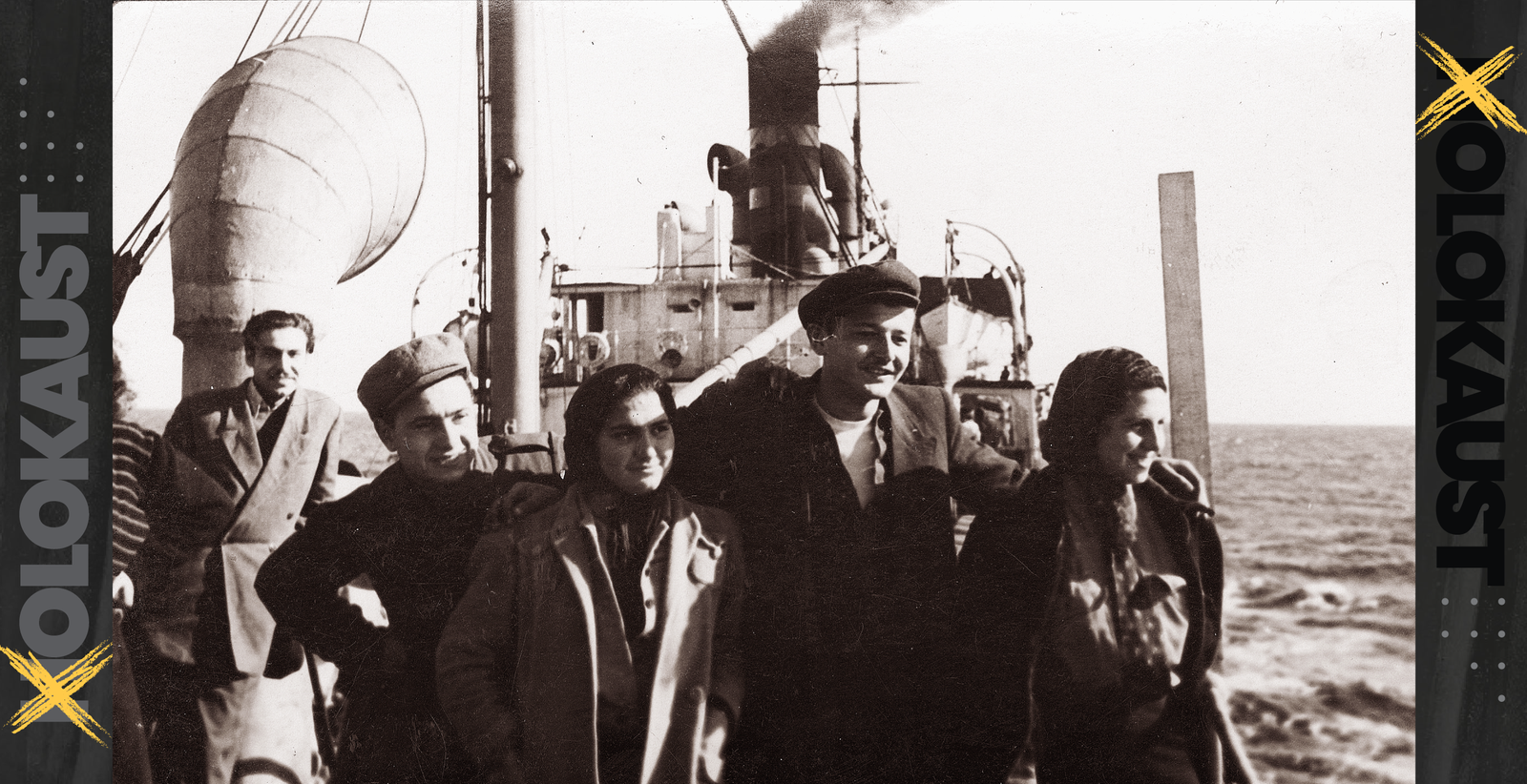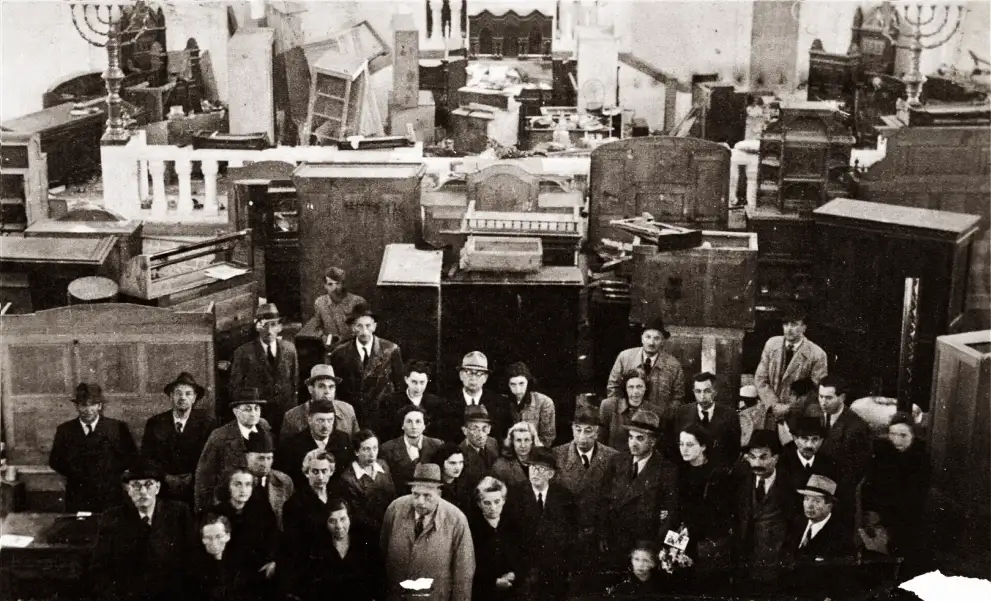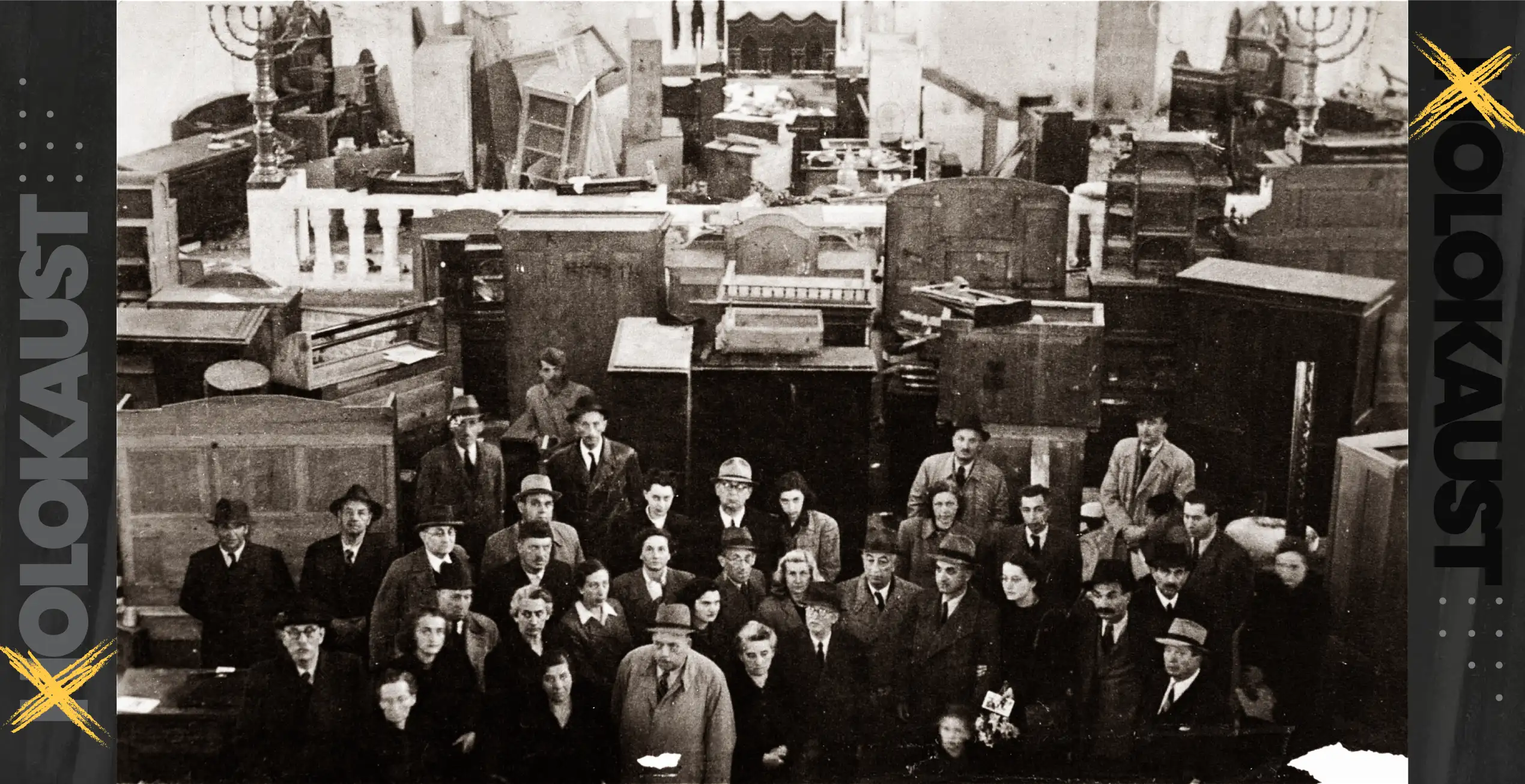
Danijel Rip (right) in front of the furniture-making and repair workshop he founded with his partner.
Date: 1937
Photo number: 55619

Danijel Rip (right) in front of the furniture-making and repair workshop he founded with his partner.
Date: 1937
Photo number: 55619
Elvira and Mira Keller, daughters of Irena Rip Keller. Killed in Auschwitz.
Date: 1938-1940
Photo number: 32027
THE HOLOCAUST
The Holocaust was a systematic, state-sponsored persecution and murder of Jews carried out by Nazi Germany between 1933 and 1945, with the support of other fascist and nationalist regimes and various local collaborators who either assisted the Germans or directly participated in the crimes of the Holocaust.
The Holocaust is a crime without precedent in history. Nazi Germany based its ideology on racist antisemitism, and in pursuit of a vision of a new world order and “living space” for the German nation, the destruction of Jews became, for the Third Reich, not just a means but also a goal and a purpose of its very existence. Even as Germany was losing the war, the killing of Jews accelerated and intensified, paradoxically, perhaps because of the imminent defeat.
The Holocaust was unprecedented because the complete apparatus of the firm and modern German state – with all its resources, capacities, administration, and organization – was mobilized for the destruction of a single minority group. Every segment, every gear, and cog of this powerful, complex mechanism worked with one goal: to kill all Jews. Ministries from economy and agriculture, energy and transport, to culture, media, education, and even family and social services, youth and sports ministries, police, and the military – all worked diligently and methodically to destroy the entire Jewish population.
The Holocaust is a crime without precedent because it unfolded across the European continent. The Nazis were not alone; they had willing accomplices throughout Europe who eagerly participated in the endeavor, often acting on their own initiative, arresting, killing, or handing over their Jewish neighbors to the Germans.
In present-day Serbia, the Holocaust was carried out by German occupation forces, Bulgarian occupiers in Pirot, Hungarian forces and local Hungarian collaborators in Bačka, part of the German minority Volksdeutsche in Banat, the Ustaše regime of the Independent State of Croatia in Srem. Serbia, too, had its collaborators and perpetrators: from Milan Nedić’s puppet regime to Dimitrije Ljotić and Kosta Pećanac’s Chetniks, and countless opportunists who exploited the misfortune of others for personal gain.
The Holocaust is a crime without precedent because it happened in full view of millions of silent bystanders who did not want to see, pretended not to see, or were afraid to see – and some, not so rarely, even rejoiced and supported what was happening. These millions of silent witnesses essentially enabled the crime to occur.
Behind this silence lies antisemitism, the oldest hatred, deeply embedded over centuries into the fabric of European cultural identity.
The Holocaust was a turning point in world history, transcending geographical boundaries and affecting every aspect of societies it touched. Decades later, we are still searching for ways to deal with the memory of the Holocaust.
The culture of Holocaust remembrance involves not only preserving the memory of the victims but also acknowledging personal and societal responsibility to recognize and oppose violations of civil and human rights. This includes confronting contemporary antisemitism and the abuse and distortion of history for the promotion of nationalism, fear, and hatred.
Hinko and Mari Rip in their garden in Novi Sad. Hinko was killed during the Novi Sad Raid. Mari was murdered in Auschwitz
Date: 1938-1940
Photo number: 32028
HOLOCAUST VICTIMS IN NOVI SAD
During World War II, the population of 4,350 Jews in Novi Sad suffered immense losses in the Holocaust. 3,020, or 70% of the Jewish community of Novi Sad, were killed.
Zločini u Bačkoj, pa tako i u Novom Sadu, vršeni su u nekoliko perioda. Odmah po ulasku mađarskih okupacionih snaga 12. i 13. aprila 1941. godine, u talasu nasilja stradalo je civilno stanovništvo Novog Sada, ali i Sombora, Subotice, Srbobrana, i šajkaških sela: Čuruga, Žablja, Titela, Mošorina, Gospođinaca, Đurđeva i drugih.
The Novi Sad Raid (Racija)
In the Novi Sad Raid (also referred to as the Raid in South Bačka, or Razzia) in January 1942, the Hungarian army and gendarmerie forces killed over 4,000 civilians, primarily Serbs and Jews. In Novi Sad alone, about 900 Jews were killed, nearly a quarter of the city’s Jewish population at the time.
Forced Labor
Throughout the Hungarian occupation, anti-Jewish measures were enforced. Jewish men aged 18 to 60 were forced into labor camps across Europe, mines, or the Eastern Front, where many were killed or perished from disease and exhaustion.
Deportation to Death Camps
After German forces occupied Hungary in March 1944, even harsher measures were imposed on Jews, including those in Bačka. Starting in April, over 424,000 Jews from Hungary and occupied territories were deported to Nazi death camps, primarily Auschwitz.
On April 26, 1944, Jews in Novi Sad were arrested, detained in the city’s synagogue without food, water, or toilets, and then deported to death camps. Of the 1,900 Jews deported from Novi Sad, only around 200 survived.
Masovna hapšenja Jevreja u Novom Sadu, kao i na teritoriji cele Bačke, nemačke i mađarske snage započele su u jutarnjim časovima 26. aprila 1944. __ Hapšeni su svi pripadnici jevrejske zajednice uključujući i decu, žene, stare i bolesne. Praktično celokupno jevrejsko stanovništvo Novog Sada sprovedeno je u novosadsku Sinagogu.
U Sinagogi su bili zatvoreni od 26. do 28. aprila bez vode, hrane i toaleta. Odatle su odvođeni transportima do sabirnih logora u Subotici, Baji i Bačkoj Topoli gde su raspoređivani i deportovani vozovima u nacističke logore smrti, uglavnom u Aušvic. Većina je ubijena u gasnim komorama odmah po dolasku u logor. Od oko 1.900 novosadskih Jevreja koji su deportovani aprila 1944. godine, preživelo je samo oko dve stotine.
Survivors
After liberation, only a few hundred Jews returned to Novi Sad. Many later emigrated, primarily to Israel, while others rebuilt their lives, forming the foundation of the renewed Jewish community in Novi Sad.
Bilo je izuzetno teško obnoviti život jevrejske zajednice Novog Sada. Oni koji su preživeli i odlučili da ostanu u Novom Sadu, koji su pronašli snagu da stvaraju novi život, osnivaju porodice i grade novu zajednicu, činili su okosnicu iz koje je izrasla nova mlada stabljika novosadske jevrejske zajednice koju imamo danas.
Danijel Rip in Novi Sad
Date: July 1940
Photo number: 32025
DANIJEL RIP
One of the Stories of Novi Sad Jews
Danijel Rip was born in Novi Sad in 1922 to Hinko and Mari Rip. __ He had a sister, Irena, and three brothers: Imre, Teodor, and Mihajlo.
Danijelov brat Teodor je još pre rata emigrirao u Sjedinjene Američke Države.
Danijelova sestra Irena se udala i kao Irena Keler rodila dve ćerke: Miru i Elviru.
Imre je bio aktivista jevrejskog socijalističko-cionističkog sekularnog omladinskog pokreta ”Hašomer hacair” (”Mladi stražar”).
Danijel je učio tapetarski i stolarski zanat. Neposredno pre početka rata pokrenuo je sopstvenu radnju za izradu i popravku nameštaja.
Tako ih je u aprilu 1941. godine zatekao slom Jugoslavije i mađarska okupacija.
Tokom Novosadske racije, 23. januara 1942, mađarski žandarmi su uhapsili Danijelovog oca Hinka. Grupi uhapšenih građana, među kojima je bio i Hinko, naređeno je da legnu na ulicu nakon čega su im pucali u potiljak. Potom su mađarski žandarmi tela žrtava bacili u Dunav.
Nakon okupacije, Imre se angažovao u pokretu otpora. Polovinom 1942, nekoliko meseci nakon što im je ubijen otac, Imre je uhapšen i poslat na prinudni rad u Ukrajinu, gde je ubijen, verovatno 1943. __ Posthumno ga je odlikovala Organizacija partizana, boraca otpora i geto pobunjenika u Tel Avivu.
Zajedno sa ostalim novosadskim Jevrejima, aprila 1944. godine, Danijelova majka Mari, sestra Irena i Irenine dve ćerke, Mira i Elvira, deportovane su u Aušvic gde su ubijene, verovatno odmah po dolasku u logor.
Danijel je još leta 1942. poslan na prinudni rad da gradi bunkere i barake za mađarsku vojsku. Tokom 1943. godine poslali su ga na mađarsku granicu da gradi puteve, i zatim dalje na istok, gde je radio u rudniku. Tamo je Danijel bio zatečen u unakrsnoj pucnjavi i ranjen u nogu. Nakon što mu je noga zarasla, ponovo je bio primoran da radi u mađarskim vojnim radnim bataljonima. Radni uslovi su bili veoma teški, a zatvorenike su svakodnevno tukli. Nakon što je sve to nekako preživeo, Danijel je krajem 1944. deportovan u Budimpeštu u geto. Tamo je upoznao svoju buduću suprugu Judit Fribert iz Čehoslovačke.
Judit i Danijel su preživeli Holokaust. Venčali su se 26. februara 1945, ni dve pune nedelje nakon što su sovjetske trupe oslobodile Budimpeštu. Odlučili su da se vrate u Novi Sad i potraže preživele rođake. Jedini preživeli bio je Danijelov brat Mihael.—-
Judit i Danijel su preživeli Holokaust. Venčali su se 26. februara 1945, ni dve pune nedelje nakon što su sovjetske trupe oslobodile Budimpeštu. Odlučili su da se vrate u Novi Sad i potraže preživele rođake. Jedini preživeli bio je Danijelov brat Mihael.
U Novom Sadu su Judit i Danijel dobili dvoje dece: Veru 1946. i Henrija 1947. __ Danijel je odmah po dolasku u Novi Sad regrutovan u Jugoslovensku armiju. Nakon što je završio vojnu službu 1948. godine, Danijel, Judit i deca, zajedno sa Danijelovim bratom Mihajlom i Mihajlovom suprugom, emigrirali su u Izrael.
Portrait of the four Rip brothers: Danijel, Imre, Mihajlo, and Teodor in Novi Sad.
Date: 1938-1940
Photo number: 55617
Irena Rip Keller and her daughters Elvira and Mira in their garden in Novi Sad. All were killed in Auschwitz.
Date: January 19th 1940
Photo number: 32026
Yugoslav Jews aboard the ship Kefalos, sailing from Bakar, Croatia to Israel.
Date: December 1948
Photo number: 24743

Yugoslav Jews aboard the ship Kefalos, sailing from Bakar, Croatia to Israel.
Date: December 1948
Photo number: 24743

Jews are assembled in the desecrated synagogue in Novi Sad before being transported to a concentration camp.
Date: April 26th 1944, Locale: Novi Sad, Vojvodina, Serbia
Photo number: 12892, Photo Credit: United States Holocaust Memorial Museum,
courtesy of Moshe and Malka Lovy, Copyright: USHMM, Provenance: Moshe and Malka Lovy, Source Record ID: Collections: 2001.336

Jews are assembled in the desecrated synagogue in Novi Sad before being transported to a concentration camp.
Date: April 26th 1944, Locale: Novi Sad, Vojvodina, Serbia
Photo number: 12892, Photo Credit: United States Holocaust Memorial Museum,
courtesy of Moshe and Malka Lovy, Copyright: USHMM, Provenance: Moshe and Malka Lovy, Source Record ID: Collections: 2001.336



Observer of the Royal Hungarian Gendarmerie for the Szeged Supervisory District
BRIEFING
Information regarding Order 6163/1944 of the Royal Hungarian Minister of the Interior
In connection with the implementation of this order, a meeting was held on April 19 at the Ministry of the Interior, presided over by Minister Baky, where the details of the process of cleansing the territory of Jews were discussed.
…The order does not currently address the covering of costs related to the relocation. It was decided that these costs would be covered from Jewish property. The establishment of collection camps will also be funded in the same way.
Jewish apartments must be locked and the collection of valuables, etc., will be carried out by a commission that includes one or two experts. Items of value — money, typewriters, bicycles, cameras — must immediately be listed in three copies and delivered to the designated branch of the National Bank. Food that spoils easily found in the apartments must also be recorded in a separate list, also in three copies. That food is to be handed over to the supply department, which will manage its distribution. The proceeds from its sale are to be deposited until the Ministry makes a decision.
As stated in the meeting, Jewish apartments should be allocated to officers, state employees, and workers who do not have adequate and healthy housing. They may also be given the use of the household furnishings, with a proper inventory list. However, whenever possible, artistic objects, paintings, carpets — items not needed for daily use — should be itemized and sent to an appropriate location for safekeeping. This also applies to fur coats, silverware, etc. The point is that all Jewish property becomes the property of the Hungarian state and must be preserved as such.
When distributing food, workers have priority, and prices are set by the authorities.
Bicycles are to be given first to the military or law enforcement. The same applies to typewriters.
WITNESS TESTIMONIES
WITNESS TESTIMONIES
MATIĆ MILIVOJ
Novi Sad
66 years old, Serb, engineer, address: Natoševićeva 15. Statement recorded on March 3, 1945.
“In my neighborhood lives — or rather, used to live — a Jewish family named Römer. On May 1, 1944, at seven in the morning, four men came for them: one in a Gestapo uniform, one police officer, and two representatives of the city administration. Mr. Römer’s wife was ill, but they showed no consideration — they forced her to go with them, along with her husband and their two children, aged 10 to 14.
Later, I found out they had been taken to the local synagogue. To this day, they have not returned. I should also mention that, by then, their entire apartment had already been cleared out and all their furniture taken away. I have nothing more to say about this matter.”
MALENČIĆ STEVAN
Novi Sad
51 years old, former clerk, Serb, Orthodox Christian, address: Kraljevića Đorđa 10.
Statement recorded on January 15, 1945.
I don’t remember the exact date. It was in April 1944. __ I don’t remember the exact date. It was in April 1944. I was in Baja, passing through from Pécs to Novi Sad, where I had to wait one day for a connection to Subotica. While there, I found out that the Jews from Novi Sad were in Baja, outside the town, about four kilometers away, in some barracks. Since I knew two women who used to live in the same house as me, I hired a carriage and went to those barracks, where I saw the Jews from Novi Sad inside a wire enclosure that had previously held Yugoslav army officers.
From about five or six steps away, through the wire, I spoke with several Jews I knew. They complained that they were sleeping on bare sand and that inside the barracks, they were packed like sardines — 1,700 of them in two barracks. The stench inside was unbearable, and they said they would rather sleep outside.
Among the people I recognized were the widow Klug and her daughter Margita, fur trader Satler from Kralja Petra II Street, grain trader Vajs Leo, Katica Berte from 6 Gajeva Street, waiter Kovač from Novi Sad, merchant Gajger from Temerinski put, sign painter Levenberg, the daughter of an installer from Petra Zrinjskog Street named Kelemen, and the shoe merchant who ran the “Astra” shoe store. I also saw the president of the Jewish religious community, Dr. Ferdinand Lustig, and many other Jews from Novi Sad whose names I no longer remember.
They all looked utterly exhausted, like walking corpses, barely able to move from weakness. Even the carriage driver told me they had been brought there during terrible weather, in heavy rain, and had been living in inhumane conditions.
IMPRESSUM
Author: Miško Stanišić
Design: Darko Vuković
Publisher: Teraforming, www.terraforming.org
Web design: Skilltech Web Design
All photos:
Source and Copyright: United States Holocaust Memorial Museum, Washington
Origin: Vera Rip Hirschhorn
Except Photo No. 24743 – Origin: Gavra Mandil
References:
- Priče smrti i života iz kutije 183, Vladimir Todorović, Teraforming
- Deportation of Bačka Jews in 1944 (Archives of Vojvodina)
- Encyclopedia of the Holocaust (USHMM)
- Teaching Materials on Antisemitism (Terraforming)
- IHRA Recommendations for Teaching the Holocaust
- The Destruction of the Hungarian Jews (Yad Vashem)
IMPRESSUM
Author: Miško Stanišić
Design: Darko Vuković
Publisher: Teraforming, www.terraforming.org
Web design: Skilltech Web Design
All photos:
Source and Copyright: United States Holocaust Memorial Museum, Washington
Origin: Vera Rip Hirschhorn
Except Photo No. 24743 – Origin: Gavra Mandil
References:
Deportation of Bačka Jews in 1944 (Archives of Vojvodina)
Encyclopedia of the Holocaust (USHMM)
Teaching Materials on Antisemitism (Terraforming)
IHRA Recommendations for Teaching the Holocaust
The Destruction of the Hungarian Jews (Yad Vashem)

Top
The Holocaust
Stradanja
Danijel Rip
Map
Testimonies
Impressum